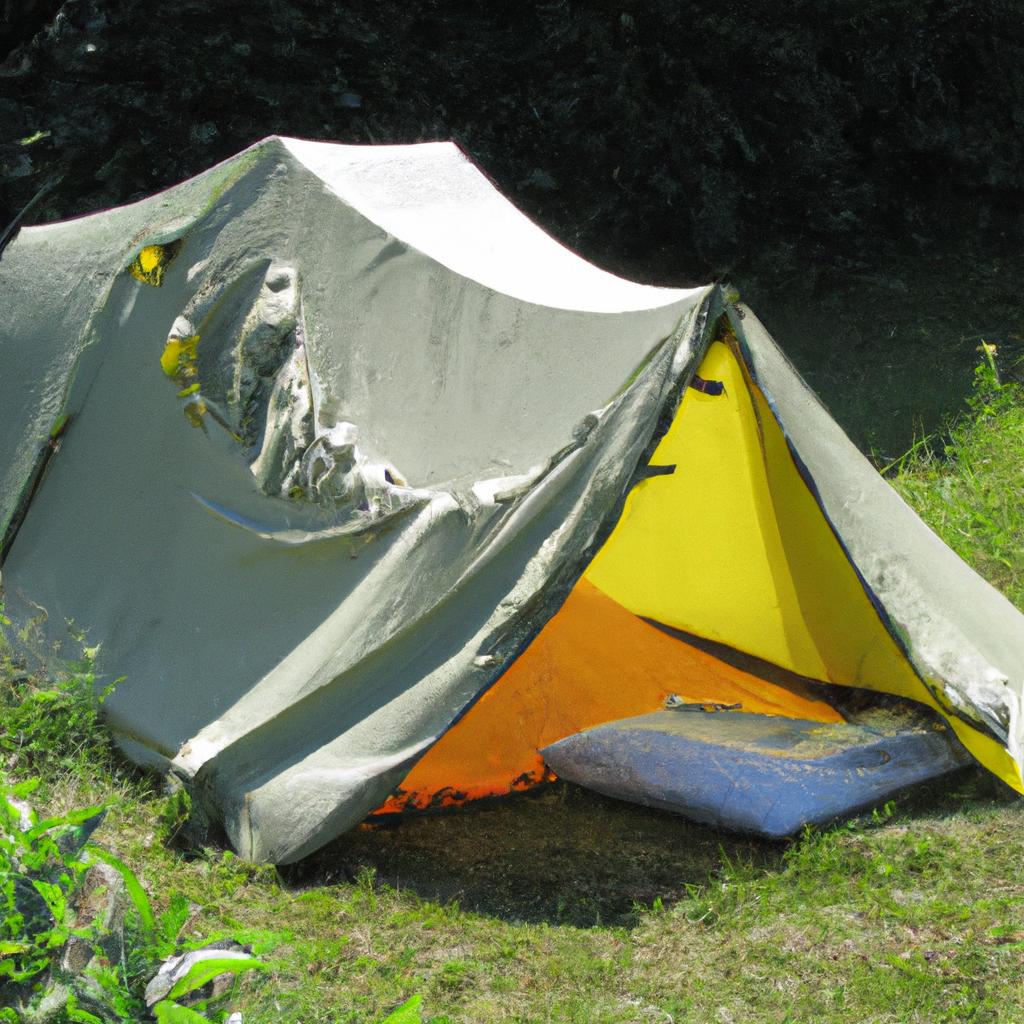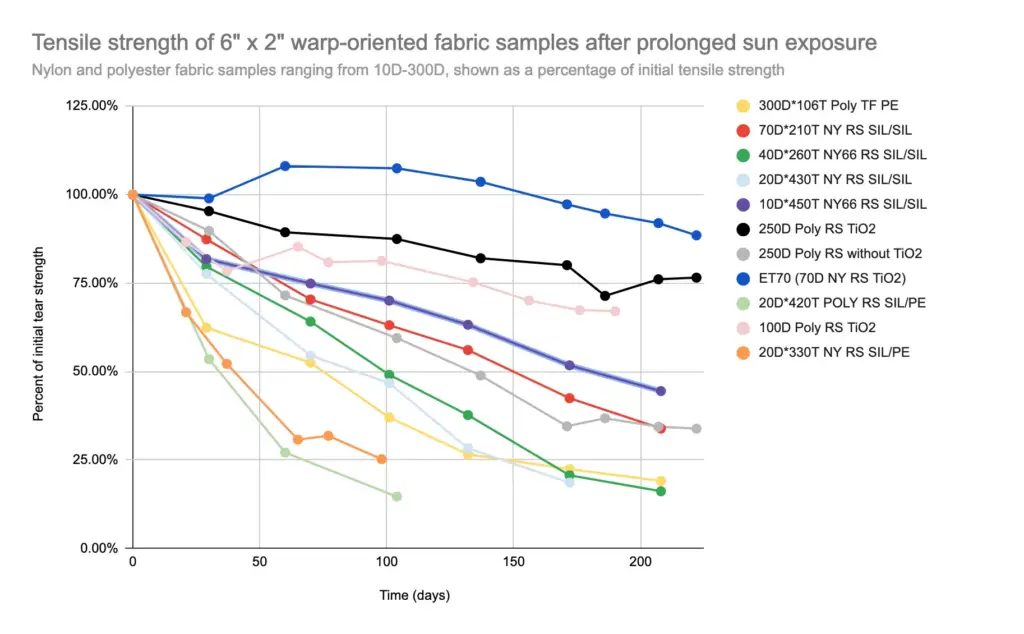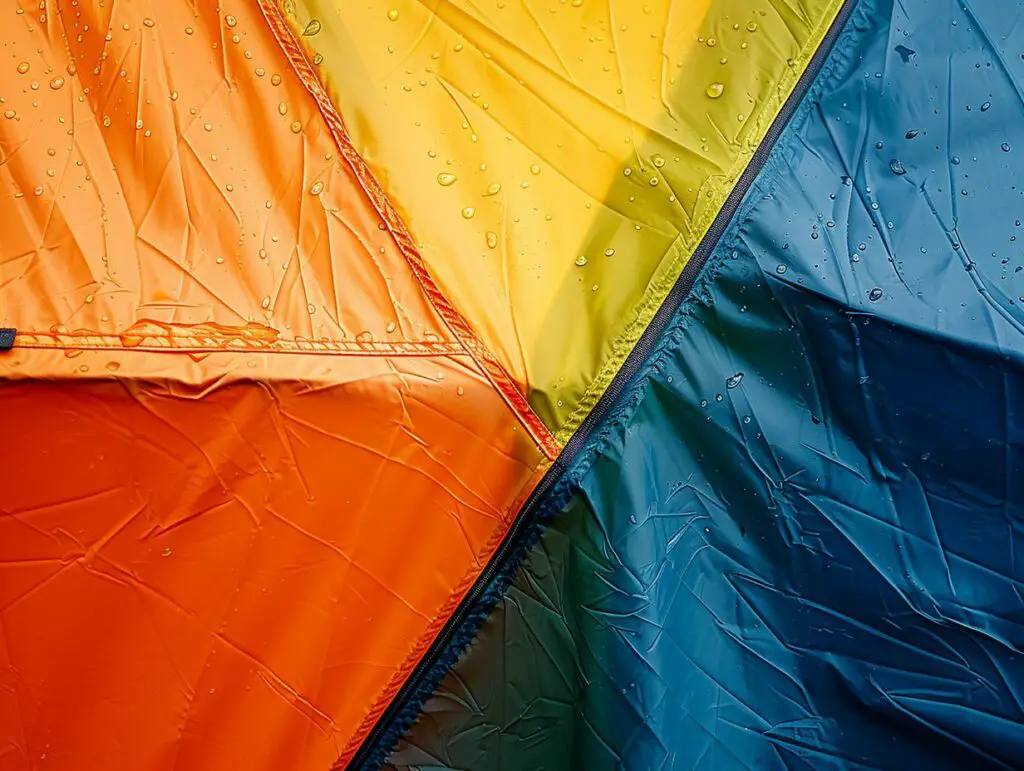As an outdoor expert, I’m often asked if nylon is UV resistant. The answer isn’t as straightforward as you might think! There’s a lot to consider when it comes to the durability of your gear in the sun and moisture.
Nylon is not inherently UV resistant. Prolonged exposure to UV radiation from sunlight can cause the material to degrade, lose strength, and become brittle over time.
However, UV resistance can be improved by adding UV stabilizers or protective coatings during the manufacturing process. To ensure UV resistance in nylon products, look for those specifically treated for UV protection or consider using alternative materials with natural UV resistance.
UV rays from the sun can be incredibly damaging to almost any material; however, there are some fabrics that offer more protection than others. Nylon is one such fabric, but does it really provide enough protection?
We’ll get into the details so you can make an informed decision about what type of materials will work best for your next adventure.
Properties Of Nylon
Nylon is an incredibly durable fabric that has a wide range of properties. It’s chemical structure gives it some unique advantages, such as stain prevention and waterproofing capabilities.

Additionally, its heat resistance makes it perfect for activities in hot climates or areas with high sun exposure.
Not only does nylon boast these impressive characteristics but it also offers great UV protection too – making it the ideal choice for everyday wear and outdoor equipment alike.
Its tight-knit weave helps to repel ultraviolet radiation from reaching your skin and provides excellent coverage against harmful UV rays.
Unfortunately, the ability of nylon to absorb UV light is also what makes it vulnerable to degradation over time.
So how exactly does the nylon respond to such UV exposure over time?
Effects Of Ultraviolet Radiation
UV radiation breaks down the bonds between the monomers in nylon tent fabric, leading to the disruption of the macromolecular structure of the nylon thread/fabric.
This causes the nylon fabric to become brittle, weak, and increasingly worse over time, which impacts its suitability for use in, for example, tents, jackets and backpacks.
The degree of damage depends on the thickness of the fabric, surface treatments, as well as the amount of UV radiation it is exposed to.

In the graph above, it is crazy to see that 5 out of 11 tent fabrics tested had lost more than half of their tensile strength after just 100 days of sun exposure!
Most of these are the thinner < 40D Nylon or polyester fabrics without any protective treatments.
Thicker fabrics may take longer to break down, but they will eventually be destroyed by UV radiation.
Therefore, it is important to protect nylon tent fabric from excessive sunlight exposure to prolong its lifespan.
Nylon protects well against UV but it degrades over time
When it comes to nylon’s UV resistance, it’s important to understand the UV protection properties of nylon and how it stands up to sunlight.
While nylon is not happy with UV light and will slowly degrade, this is actually good news for your skin!
Not only that but thanks to innovative dyeing techniques, nylon fabrics can be treated in such a way as to provide excellent ultraviolet ray protection.

Nylon fabric is widely appreciated for its numerous advantageous properties, including its effectiveness in blocking ultraviolet (UV) light. This feature makes nylon an excellent choice for protective clothing and other applications where UV protection is essential.
The fabric’s structure allows it to absorb UV radiation, thus protecting the skin from harmful sun rays that can lead to skin cancer and other skin-related issues.
However, despite its UV-blocking capabilities, nylon has a significant drawback: it is prone to degradation when exposed to sunlight over time. This degradation is primarily due to the photochemical reactions that occur when the nylon polymers are exposed to UV light.
These reactions can break down the molecular chains in the polymer, leading to a loss of mechanical strength and elasticity, as well as changes in color and texture. The material becomes brittle and weak, significantly reducing its useful life in applications such as outdoor gear, clothing, and other textiles frequently exposed to the elements.
The degradation process is influenced by several factors, including the intensity and duration of sun exposure, the presence of atmospheric pollutants, and the specific type of nylon. For instance, some nylon formulations may include UV stabilizers and other additives to enhance resistance to sunlight, thereby slowing down the degradation process.
To mitigate these effects, manufacturers often treat nylon fabrics with UV inhibitors and antioxidants. These treatments can help to extend the lifespan of the products by protecting the polymer chains from the oxidative and hydrolytic effects of UV exposure.
Additionally, proper care and maintenance, such as avoiding prolonged exposure to direct sunlight and following specific washing guidelines, can also help to prolong the durability and aesthetic appeal of nylon products.
In summary, while nylon is effective at protecting against UV light, its susceptibility to photo-degradation remains a significant challenge. Advances in polymer chemistry and textile engineering continue to focus on enhancing the UV resistance of nylon to improve its performance and durability in long-term applications.
Maintenance Practices For UV Resistant Nylon
After exploring the attributes of nylon that make it UV resistant, let’s now look at some maintenance techniques to ensure that your outdoor projects remain protected from sunlight damage.
There is no way to fully protect tent fabrics from UV degradation, as all organic polymers (including synthetic materials like nylon and polyester) are susceptible to damage from UV radiation.
However, using higher quality nylon fabrics with superior UV resistance can help slow the process of degradation. Additionally, storing tents out of direct sunlight and using tent covers or tarps can also help minimize UV damage to the fabrics.
To keep your fabrics looking their best and prevent sun-related fading or tearing, here are five tips you should consider:
- Cleaning Techniques – Always use a gentle cleaner when washing synthetic fabrics. Selecting one specifically designed for outdoor textiles will help preserve its color and strength.
- Temperature Control – Store away any fabric items out of direct sunlight during hot days and try to avoid exposing them to extreme temperatures.
- Coatings Applied – Consider using a water repellent spray on specific parts of the fabric that may be exposed to more rain or moisture than others. This can help protect against further damage caused by humidity.
- Light Exposure – Keep an eye on how much light your fabrics receive each day; if possible, move them into shade or cover them up with another material when not in use.
- Fabric Care– Be sure to properly care for your fabrics according to the product instructions provided by the manufacturer before taking them outdoors again.
So there you have it – follow these steps and you’ll prolong the life of your nylon products while preserving their vibrant colors!
Frequently Asked Questions
How Much More UV Resistant Is Nylon Compared To Other Fabrics?
Nylon not super resistant to UV damage compared to for example cotton or polyester, but its breathability benefits make it a great option for keeping cool during hot summer days. And when washing instructions must be followed, nylon stands resilient against fading or discoloration after multiple washes.
Whether you’re looking for durable fabric that will keep you safe from harmful UV rays or just need something lightweight that won’t wear down easily, choosing nylon offers more than just comfort—it gives you the freedom of being able to enjoy the outdoors without worry.
Is There A Difference In The Level Of UV Resistance Between Different Types Of Nylon?
Yes, there are differences in the level of UV resistance between different types of nylon!
Whether you’re an outdoor enthusiast looking for sun protection or a fabric coating expert searching for optimal UV protection, it’s important to be aware that some nylon fabrics offer more protection than others.
This can depend on various factors such as the quality of weaving, chemical treatments and coatings applied to the fabric.
Fortunately modern-day technologies have made it easier than ever to find specialized coatings that provide maximum sun protection while still maintaining flexibility and softness.
Can Nylon Be Dyed To Increase Its Uv Resistance?
Dyeing nylon fabric to increase its UV protection may seem like a daunting task, but with the right weaving techniques and care instructions it’s totally possible!
As an outdoor expert I can assure you that not all dyeing methods are equal when it comes to protecting your fabrics from harmful rays.
It is important to understand how best to use these techniques while also taking into account various other factors such as intensity of sunlight exposure, weather conditions and more.
With careful consideration of all variables involved, the right dyeing method will help ensure long-term fabric protection and ultimately give you greater freedom in those moments spent outdoors.
What Is The Best Way To Store Nylon In Order To Maximize Its Uv Resistance?
Storing nylon to maximize its UV resistance can be a tricky endeavor. As an outdoor expert, I recommend storing your nylon gear in the dark or pre-treating your fabric with UV protecting chemicals and cleaning it regularly to ensure optimal UV protection and strength.
Additionally, choosing the right fabric is essential; pick the one best suited for your climate and lifestyle needs.
Finally, consider dyeing processes that are specifically designed to increase your fabric’s resistance to sunlight exposure.
With these tips in mind, you’ll be able to hit the trails ready for anything nature throws at you!
Are There Any Special Care Instructions For Maintaining Uv Resistant Nylon?
Maintaining uv resistant nylon requires special care instructions.
As an outdoor expert, I recommend cleaning techniques that are specific to the fabric construction of your nylon garments or accessories.
Additionally, color selection and weather protection should be taken into consideration when developing a maintenance strategy for your items.
Special attention can help ensure you get the most out of this durable material as it resists UV radiation without sacrificing comfort and style.
Conclusion
In conclusion, nylon is not an incredibly UV-resistant fabric. When compared to other fabrics, it stands out for its ability to protect against the damaging effects of prolonged exposure to ultraviolet rays, but it will break down over time.
However, different types of nylon offer varying levels of protection and some can be further treated with dyes or special care instructions in order to maximize their resistance.
When caring for nylon fabric that has been designed to be UV resistant, it’s important to store it properly in order to maintain its protective properties. Sunlight will slowly diminish the level of protection over time so keeping your clothing stored away from direct sunlight when not in use is essential.
Additionally, if you take proper precautions like using a garment bag and avoiding harsh detergents or bleach when washing, you should have no problem maintaining the integrity of this resilient material.
Think of treating your outdoor wear made from nylon as though you were tending a garden – carefully cultivating each piece so that it continues blooming with lasting beauty and resilience just like a flower does under the warm sunrays. With a little bit of extra attention and TLC, you’ll find that your garments made from nylon are well equipped to withstand even the most intense UV radiation nature throws at them!




